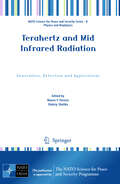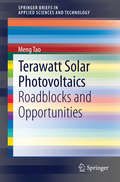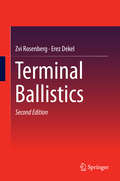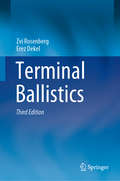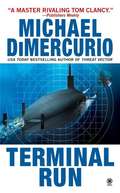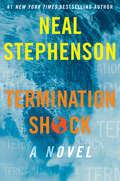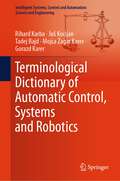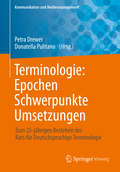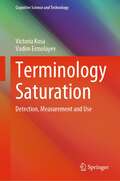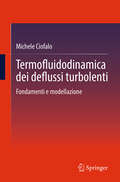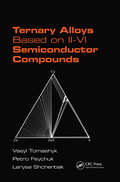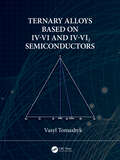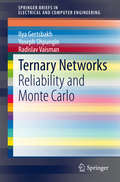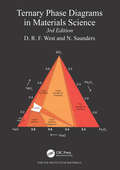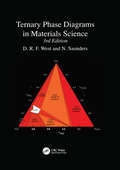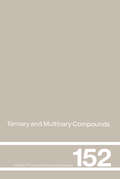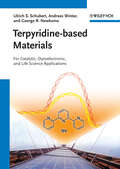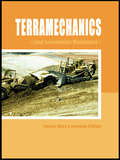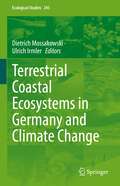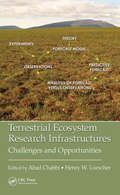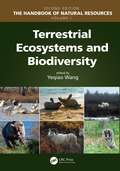- Table View
- List View
Terahertz and Mid Infrared Radiation
by Oleksiy Shulika Mauro F. PereiraTerahertz (THz) and Mid-Infrared (MIR) radiation (TERA-MIR) can be transmitted through nearly any material without causing biological harm. Novel and rapid methods of detection can be created with devices operation in these spectral ranges allowing scanning for weapons, detecting hidden explosives (including plastic landmines), controlling the quality of food and a host of other exciting applications. This book focuses on mathematical and physical aspects of the field, on unifying these two spectral domains (THz and MIR) with regard to common sources, detectors, materials and applications, and on key interdisciplinary topics. The main THz and MIR source is the quantum cascade laser (QCL). Thus significant attention is paid to the challenge of turning this advanced technology into affordable commercial devices so as to exploit its enormous potential. However other alternatives to THz QCLs are also presented, e.g. sub-terahertz imaging from avalanching GaAs bipolar transistors, Josephson junctions as THz sources, semiconductor materials for pulsed THz sources, superconducting THz electronics with Josephson vortices. In summary this book delivers a global picture of the state of the art in TERA-MIR generation, detection and applications.
Terawatt Solar Photovoltaics
by Meng TaoSolar energy will undoubtedly become a main source of energy in our life by the end of this century, but how big of a role will photovoltaics play in this new energy infrastructure? Besides cost and efficiency, there are other barriers for current solar cell technologies to become a noticeable source of energy in the future. Availability of raw materials, energy input, storage of solar electricity, and recycling of dead modules can all prevent or hinder a tangible impact by solar photovoltaics. This book is intended for readers with minimal technical background and aims to explore not only the fundamentals but also major issues in large-scale deployment of solar photovoltaics. Thought-provoking ideas to overcoming some of the barriers are discussed.
Terminal Ballistics
by Zvi Rosenberg Erez DekelThis monograph covers all important issues of terminal ballistics in a comprehensive way combining experimental data, numerical simulations and analytical modeling. It uses a unique approach to numerical simulations as sensitivity measure for the major physical parameters. In the first chapter, the book includes necessary details about the experimental equipment which are used for ballistic tests. The second chapter covers essential features of the codes which are used in recent years all over the world, the Euler vs. Lagrange schemes, meshing techniques etc. The third chapter, devoted to the penetration mechanics of rigid rods, brings the update of modeling in this field. The fourth chapter deals with plate perforation and the fifth chapter deals with the penetration of shaped charge jets and eroding long rods. The last chapter includes several techniques for the disruption and defeating of the main threats in armor design. Throughout the book the authors demonstrate the advantages of the simulation approach in understanding the basis physics behind the investigated phenomena.
Terminal Ballistics
by Zvi Rosenberg Erez DekelThis book comprehensively discusses essential aspects of terminal ballistics, combining experimental data, numerical simulations and analytical modeling.This new, 3rd edition reflects a number of recent advances in materials science, such as the use of polyurea layers on metallic plates in order to improve their ballistics. In addition, more data and analyses are now available on dwell and interface defeat in ceramic tiles coated with polymers, and are presented here. Lastly, the new edition includes new results, numerical and empirical, concerning the DIF issue in brittle solids, as well as the “upturn” phenomenon in the stress–strain curves of ductile solids.The author also added a new analysis of concrete penetration experiments which accounts for the scaling issue in this field. This is a new,and important, addition which we are happy to announce. They also added some new insights into the interaction of EEP’s and FSP projectiles with metallic plates.Throughout the book, the authors demonstrate the advantages of the simulation approach in terms of understanding the basic physics behind the phenomena investigated, making it a must-read for all professionals who need to understand terminal ballistics.
Terminal Run
by Michael DimercurioOne ship could revolutionize submarine warfare as we know it: the USS Snarc. A robotic combat sub carrying no crew, the Snarc has proven unbeatable in sea trials. And now, it has fallen into the hands of an unseen enemy. The Snarc's first casualty: the nuclear sub carrying the son of retired Admiral Michael Pacino. The only man who can match wits with the Snarc, Pacino re-enters the game in a high-tech underwater battle unlike any that's been fought before, one that could engulf the world in war-and bring him face to face with his most hated nemesis.
Termination Shock: A Novel
by Neal StephensonNew York Times BestsellerFrom Neal Stephenson—who coined the term “metaverse” in his 1992 novel Snow Crash—comes a sweeping, prescient new thriller that transports readers to a near-future world in which the greenhouse effect has inexorably resulted in a whirling-dervish troposphere of superstorms, rising sea levels, global flooding, merciless heat waves, and virulent, deadly pandemics.“Stephenson is one of speculative fiction’s most meticulous architects. . . . Termination Shock manages to pull off a rare trick, at once wildly imaginative and grounded.” — New York Times Book ReviewOne man—visionary billionaire restaurant chain magnate T. R. Schmidt, Ph.D.—has a Big Idea for reversing global warming, a master plan perhaps best described as “elemental.” But will it work? And just as important, what are the consequences for the planet and all of humanity should it be applied?Ranging from the Texas heartland to the Dutch royal palace in the Hague, from the snow-capped peaks of the Himalayas to the sunbaked Chihuahuan Desert, Termination Shock brings together a disparate group of characters from different cultures and continents who grapple with the real-life repercussions of global warming. Ultimately, it asks the question: Might the cure be worse than the disease?Epic in scope while heartbreakingly human in perspective, Termination Shock sounds a clarion alarm, ponders potential solutions and dire risks, and wraps it all together in an exhilarating, witty, mind-expanding speculative adventure.
Terminological Dictionary of Automatic Control, Systems and Robotics (Intelligent Systems, Control and Automation: Science and Engineering #104)
by Tadej Bajd Juš Kocijan Gorazd Karer Rihard Karba Mojca Žagar KarerThis dictionary contains terms from the fields of automatic control, which includes mathematical modelling, simulation of dynamic systems, automation technology with its corresponding elements, and robotics. It also includes signal processing, information technologies and production technologies.The terminological dictionary is primarily aimed at experts and students who deal with control technology and dynamic systems in both technical and non-technical domains. To be able to use the dictionary, at least basic knowledge in this field is required. In the dictionary users will find concise terminological definitions. A concept may be designated by different terms; therefore, cross-references are used. The aim of the dictionary is to collect and unify – at least to an achievable extent – the terminology in the field of automatic control, dynamic systems and robotics.
Terminologie: Zum 25-jährigen Bestehen des Rats für Deutschsprachige Terminologie (Kommunikation und Medienmanagement)
by Petra Drewer Donatella PulitanoAlle, die sich mit fachsprachlichen Texten beschäftigen, beschäftigen sich automatisch auch mit Terminologie: Beim Lesen von Fachtexten nehmen sie die darin enthaltene Terminologie auf, beim Verfassen von Fachtexten verwenden oder produzieren sie Terminologie, beim Fachübersetzen übertragen sie Terminologie in andere Sprachen.Im Laufe der Zeit haben sich Methoden und Verfahren entwickelt, wie man professionell und effizient mit Terminologie arbeitet. Die Auseinandersetzung mit den Grundsätzen der Terminologiearbeit hat sich zu einer wissenschaftlichen Disziplin entwickelt.Der Rat für Deutschsprachige Terminologie (RaDT) wurde 1994 als Initiative der UNESCO-Kommissionen Deutschlands, Österreichs und der Schweiz gegründet, um terminologische Aktivitäten zu fördern. Zu seinem 25-jährigen Bestehen erscheint nun dieser Sammelband, der einen Überblick über das vielfältige Schaffen und das gesamte Themenspektrum der RaDT-Mitglieder bietet.Um die verschiedenen Perspektiven innerhalb der RaDT-Gemeinschaft angemessen wiederzugeben, umfasst der Band vier Themenbereiche:1. Vielfalt an Epochen2. Vielfalt an Schwerpunkten3. Vielfalt an Umsetzungen (in öffentlichen Institutionen)4. Vielfalt an Umsetzungen (in der Privatwirtschaft)Dieser Sammelband richtet sich an alle, die sich mit Terminologie, Terminologiewissenschaft oder Terminologiearbeit befassen, insbesondere in Unternehmensbereichen wie Sprachmanagement, Terminologiemanagement, Corporate Language, Wissensmanagement, sowie an Studierende und Wissenschaftler in den entsprechenden Disziplinen.
Terminology Saturation: Detection, Measurement and Use (Cognitive Science and Technology)
by Vadim Ermolayev Victoria KosaThis book highlights an innovative approach for extracting terminological cores from subject domain-bounded collections of professional texts. The approach is based on exploiting the phenomenon of terminological saturation. The book presents the formal framework for the method of detecting and measuring terminological saturation as a successive approximation process. It further offers the suite of the algorithms that implement the method in the software and comprehensively evaluates all the aspects of the method and possible input configurations in the experiments on synthetic and real collections of texts in several subject domains. The book demonstrates the use of the developed method and software pipeline in industrial and academic use cases. It also outlines the potential benefits of the method for the adoption in industry.
Termofluidodinamica dei deflussi turbolenti: Fondamenti e modellazione
by Michele CiofaloIl testo fornisce i fondamenti teorici della turbolenza e una panoramica completa dei modelli di turbolenza, dai più semplici ai più avanzati, tra cui la simulazione diretta e la simulazione Large Eddy. Si concentra principalmente sui problemi di modellazione e calcolo e fornisce informazioni sulla teoria dei sistemi dinamici e sulle loro biforcazioni. Esamina anche aspetti della turbolenza che non sono trattati nella maggior parte dei libri esistenti su questo argomento, come la turbolenza in convezione libera e mista, la turbolenza transitoria e la transizione alla turbolenza. Il libro adotta la notazione tensoriale, che è la più appropriata per trattare quantità intrinsecamente tensoriali come le sollecitazioni e i tassi di deformazione, e per coloro che non hanno familiarità con essa viene fornita un'appendice sull'algebra tensoriale e sulla notazione tensoriale.
Termofluidodinamica: Problemi insoliti con soluzioni analitiche
by Michele CiofaloQuesto libro raccoglie dieci problemi di termofluidodinamica che richiedono l'uso di soluzioni analitiche. Tutti i problemi discussi sono stati affrontati dall'autore durante la sua attività di ricerca, alcune delle soluzioni sono un suo contributo, mentre altre sono risultati classici della letteratura o possono essere derivate da essi. I fenomeni fisici coinvolti vanno dall'idrodinamica pura al flusso con trasferimento di calore o di massa, al flusso bifase e alla magnetoidrodinamica. I problemi discussi non sono canonici; si trovano raramente nei libri di testo e spesso presentano soluzioni sorprendenti o addirittura paradossali. I lettori potenziali del volume sono studenti, docenti e scienziati in campo scientifico e ingegneristico interessati alla fluidodinamica e al trasferimento di calore/massa: a loro potrà offrire spunti di riflessione, suggerimenti per lezioni o esercitazioni e idee per ulteriori sviluppi originali.
Ternary Alloys Based on II-VI Semiconductor Compounds
by Vasyl Tomashyk Petro Feychuk Larysa ShcherbakDoped by isovalent or heterovalent foreign impurities (F), II-VI semiconductor compounds enable control of optical and electronic properties, making them ideal in detectors, solar cells, and other precise device applications. For the reproducible manufacturing of the doped materials with predicted and desired properties, manufacturing technologists
Ternary Alloys Based on III-V Semiconductors
by Vasyl TomashykIII-V semiconductors have attracted considerable attention due to their applications in the fabrication of electronic and optoelectronic devices as light-emitting diodes and solar cells. Because of their wide applications in a variety of devices, the search for new semiconductor materials and the improvement of existing materials is an important field of study. This new book covers all known information about phase relations in ternary systems based on III-V semiconductors. This book will be of interest to undergraduate and graduate students studying materials science, solid state chemistry, and engineering. It will also be relevant for researchers at industrial and national laboratories, in addition to phase diagram researchers, inorganic chemists, and solid state physicists.
Ternary Alloys Based on IV-VI and IV-VI2 Semiconductors
by Vasyl TomashykIV-VI and IV-VI2 semiconductors are among the most interesting materials in semiconductor physics. The electrical properties of these semiconductors can also be tuned by adding impurity atoms. These semiconductors either have already found use or are promising materials for infrared sensors and sources, thermoelectric elements, solar cells, memory elements, etc. The basic characteristics of these compounds, namely, narrow bandgap, high permittivity, relatively high radiation resistance, high mobility of charge carriers, and high bond ionicity, are unique among semiconductor substances. Because of their wide application in various devices, the search for new semiconductor materials and the improvement of existing materials is an important field of study. Doping with impurities is a common method of modifying and diversifying the properties of physical and chemical semiconductors. This book covers all known information about phase relations in ternary systems based on IV-VI and IV-VI2 semiconductors, providing the first systematic account of phase equilibria in ternary systems and making research originally published in Russia accessible to the wider scientific community. This book will be of interest to undergraduate and graduate students studying materials science, solid state chemistry, and engineering. It will also be relevant for researchers at industrial and national laboratories, in addition to phase diagram researchers, inorganic chemists, and solid-state physicists.FEATURES Provides up-to-date experimental and theoretical information Allows readers to synthesize semiconducting materials with predetermined properties Delivers a critical evaluation of many industrially important systems presented in the form of two-dimensional sections for the condensed phases
Ternary Networks
by Radislav Vaisman Ilya Gertsbakh Yoseph ShpunginTernary means "based on three". This book deals with reliability investigations of networks whose components subject to failures can be in three states -up, down and middle (mid), contrary to traditionally considered networks having only binary (up/down) components. Extending binary case to ternary allows to consider more realistic and flexible models for communication, flow and supply networks
Ternary Phase Diagrams in Materials Science
by D. R. WestThis book provides an introductory treatment of ternary equilibrium diagrams. It presents case studies in the field of metallurgy and material science. It is useful for undergraduates and postgraduates and scientists, who wish to acquire an understanding of ternary phase diagrams.
Ternary Phase Diagrams in Materials Science
by D. R. WestThis book serves undergraduates, postgraduates, and scientists in materials science who wish to acquire or extend their understanding of ternary phase diagrams. Emphasis is given to the use of phase diagrams as a means of understanding phase changes that occur as a function of temperature.
Ternary and Multinary Compounds: Proceedings of the 11th International Conference, University of Salford, 8-12 September, 1997 (Institute Of Physics Conference Ser. #152)
by R D Tomlinson; A E Hill; R D PilkingtonMultinary compounds are now used in a wide range of devices, including photovoltaic solar cells, light emitters and detectors, and piezoelectric actuators. Ternary and Multinary Compounds provides an interdisciplinary forum for scientists and engineers working on fundamental and applied aspects of these materials. The volume focuses on optoelectronic properties, electronic band structure, charge carrier transport, optical and magnetic properties, and superconductivity. It includes chapters on the research and development of new techniques and novel materials, such as laser ablation deposition and ferroelectrics.
Terpyridine-based Materials
by Andreas Winter Ulrich S. Schubert George R. NewkomeIn recent years, the utilization of terpyridines both in macromolecular structure assembly and device chemistry has exploded, enabling, for example, supramolecular polymer architectures with switchable chemical and physical properties as well as novel functional materials for optoelectronic applications such as light-emitting diodes and solar cells. Further applications include the usage of terpyridines and their metal complexes as catalysts for asymmetric organic reactions and, in a biological context, as anti-tumor agents or biolabels.This book covers terpyridine-based materials topics ranging from syntheses, chemistry, and multinuclear metal complexes, right up to functionalized polymers, 3D-architectures, and surfaces.The book is of interest for materials scientists, (in)organic chemists, polymer chemists, complex chemists, physical chemists, biochemists, and libraries.
Terra Preta: How the World's Most Fertile Soil Can Help Reverse Climate Change and Reduce World Hunger
by Tim Flannery Hans-Peter Schmidt Kathleen Draper Haiko Pieplow Ute ScheubTerra preta is the Portuguese name of a type of soil which is thought to have almost miraculous properties. The newspapers are flooded with reports about "black gold," scientists believe that two of the greatest problems facing the world - climate change and the hunger crisis - can be solved by it. The beauty of it is that everyone can do something about it because since 2005 the secret of producing this black soil has been revealed - and it is a secret that seemed to have been lost forever with the downfall of the once thriving Indian culture of the Amazon basin. The recipe is astonishingly simple as all you need are kitchen or garden wastes, charcoal and earthworms, so it can be produced on every balcony or on the smallest of garden plots.The trio of authors Scheub, Pieplow and Schmidt, set off on a treasure hunt and condensed all the knowledge about the world's most fertile soil into a convenient guidebook. In addition to a sound instruction manual on producing terra preta and organic charcoal (biochar), the handbook covers fundamental principles from climate farming to closed-loop economy. It makes a passionate plea against synthetic fertilizers and genetic technology and offers indispensable advice to all those who feel strongly about healthy food.
Terramechanics: Land Locomotion Mechanics
by T. Muro J. O'BrienTerramechanics is the broad study of terrain-vehicle systems. In this book, all physical processes associated with the static and dynamic interplay between powered and tooled wheeled or tracked vehicles with natural and man-made surfaces are analysed and mathematically modelled.The focus of the book is the technical problem of predicting the p
Terramechanik und Geländefahrzeuge: Reifen-Boden-System, Messmethoden, Fahrzeugtechnik (ATZ/MTZ-Fachbuch)
by Jarosław PytkaAuf welche Besonderheiten trifft man bei Konstruktion, Antrieb und Fahrdynamik eines Geländewagens? Wie und womit werden die fahrdynamischen Parameter eines Geländefahrzeuges gemessen und wie berücksichtigt man sie bei Design und Konstruktion? Welche Mechanismen der Kraftübertragung des Reifens auf den Boden sollen berücksichtigt werden? Und warum ist die Bodenverformung so wichtig für die Fahrdynamik auf dem Gelände? Auf all diese Fragen gibt dieses Buch eine Antwort. Es behandelt – Grundlagen der Bodenphysik – Mechanik des Reifen-Bodensystems – Berechnungsmodelle – Mobilitätmesszahlen – Messmethoden und Testverfahren. Daneben geht es auch um Besonderheiten der Geländefahrzeuge, Konstruktion, Antrieb, Fahrwerk und spezifische Ausrüstung. Der Text behandelt Fahrdynamik auf dem Gelände gemeinsam mit experimentellen Feldmessungen und der Modellierung. Zahlreiche Abbildungen, Fotos und Tabellen erleichtern das Verständnis. Für Ingenieure und Fachleute ist das Buch ein praxisnaher Ratgeber. Professoren und Studenten bedienen sich des Werks als objektives, herstellerunabhängiges Fachbuch mit grundlagenorientierten Berechnungsbeispielen. Auch Offroadtechniker werden an diesem Buch Gefallen finden.
Terrestrial Coastal Ecosystems in Germany and Climate Change (Ecological Studies #245)
by Ulrich Irmler Dietrich MossakowskiClimate change is one of the most severe dangers for mankind worldwide. Beside the temperature increase, the sea level will rise and flood wide coastal areas, which is already remarkable today. The effects will be dramatic, in particular, at coasts with low elevation gradients such as at the German coasts of the North and Baltic Sea. The impact will be not only severe for coastal people, but still more for the unique coastal ecosystems, which harbors many plant and animal species that are already endangered today.This book focuses on the coastal terrestrial ecosystems of the German North and Baltic Sea. It describes the reactions of plants and animals (i.e. spiders, carabid beetles, bees and nematodes) on the future temperature and sea level increase. The combination of field and experimental studies is unique for Europe and for many parts of the world. It not only studies the actual elevation gradients and the climatic and saline gradients from West to East, but also the historical changes to document processes at coastal ecosystems that were already passed. In contrast to many books that studied the marine processes with similar backgrounds, this book concerns the terrestrial coastal ecosystems that were overall rarely studied and, in particular, never studied under this specific viewpoint.
Terrestrial Ecosystem Research Infrastructures: Challenges and Opportunities
by Abad Chabbi Henry W. LoescherTerrestrial Ecosystem Research Infrastructures: Challenges and Opportunities reveals how environmental research infrastructures (RIs) provide new valuable insights on ecological processes that cannot be realized by more traditional short-term funding cycles and are integral to understand our changing world. This book bonds the latest state-of-the-science knowledge on environmental RIs, the challenges in creating them, their place in addressing scientific frontiers, and the new perspectives they bear. Each chapter is thoughtfully invested with fresh viewpoints from the environmental RI vantage as the authors explore and explain many topics such as the rationale and challenges in global change, field and modeling platforms, new tools, challenges in data management, distilling information into knowledge, and new developments in large-scale RIs. This work serves an advantageous guide for academics and practitioners alike who aim to deepen their knowledge in the field of science and project management, and logistics operations.
Terrestrial Ecosystems and Biodiversity
by Yeqiao WangAuthored by world-class scientists and scholars, The Handbook of Natural Resources, Second Edition, is an excellent reference for understanding the consequences of changing natural resources to the degradation of ecological integrity and the sustainability of life. Based on the content of the bestselling and CHOICE-awarded Encyclopedia of Natural Resources, this new edition demonstrates the major challenges that the society is facing for the sustainability of all well-being on the planet Earth. The experience, evidence, methods, and models used in studying natural resources are presented in six stand-alone volumes, arranged along the main systems of land, water, and air. It reviews state-of-the-art knowledge, highlights advances made in different areas, and provides guidance for the appropriate use of remote sensing and geospatial data with field-based measurements in the study of natural resources. Volume 1, Terrestrial Ecosystems and Biodiversity, provides fundamental information on terrestrial ecosystems, approaches to monitoring, and impacts of climate change on natural vegetation and forests. New to this edition are discussions on biodiversity conservation, gross and net primary production, soil microbiology, land surface phenology, and decision support systems. This volume demonstrates the key processes, methods, and models used through many case studies from around the world. Written in an easy-to-reference manner, The Handbook of Natural Resources, Second Edition, as individual volumes or as a complete set, is an essential reading for anyone looking for a deeper understanding of the science and management of natural resources. Public and private libraries, educational and research institutions, scientists, scholars, and resource managers will benefit enormously from this set. Individual volumes and chapters can also be used in a wide variety of both graduate and undergraduate courses in environmental science and natural science at different levels and disciplines, such as biology, geography, earth system science, and ecology.
